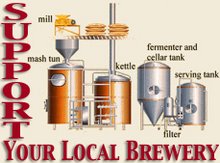Insight into Tuckahoe Brewing's expansion
 |
| Jim McAfee (right) on a tour Saturday ... a growler to go |
Now, here's some insight into the 17-month-old brewery's efforts to move away from its start-up brewing system and boost its brewing volume.
Founders Matt McDevitt, Tim Hanna, Chris Konicki and Jim McAfee are in the process of closing on the financing that will enable the brewery to step up to a larger brewhouse and corresponding fermentation tanks to keep up with a demand that is running well ahead of supply.
"It looks like we'll be getting this stuff in October or November, and maybe operating on it by the new year at some point," says Matt, who handles Tuckahoe's brewing duties, turning out a lineup of pale ale, Belgian wit, smoked porter and stout.
Matt and his partners are also in the process of tricking out their tasting room to add a bar.
"We're at the point where we can't brew any more than we are brewing, and the demand is such that our distributor is having to hold beer back from certain places because we don't make that much," he says.
 The plan right now, Matt says, is to remain in the Dennis Township location where the brewery launched in December 2011 and take over some adjacent space in the business park building that also houses a coffee roaster. (The neighboring roaster's Sumatran and Honduran beans were used in Tuckahoe's New Brighton Coffee Stout. The beer won best in show at the Atlantic City beer fest last month).
The plan right now, Matt says, is to remain in the Dennis Township location where the brewery launched in December 2011 and take over some adjacent space in the business park building that also houses a coffee roaster. (The neighboring roaster's Sumatran and Honduran beans were used in Tuckahoe's New Brighton Coffee Stout. The beer won best in show at the Atlantic City beer fest last month).
Exactly what size brewhouse Tuckahoe acquires to replace the 3-barrel PsychoBrew set-up now in use could go a couple of ways.
"We're probably heading to a 15-barrel brewhouse, possibly a 20 at the biggest. That kind of depends on used equipment," Matt says. "If something comes up that's 20 barrels that's used, we'll probably jump on that. But that's hit or miss. You can't depend on (finding) used equipment."
Used equipment has been a way to get start-up breweries into business sooner than later. But the market for used equipment has tightened sharply over the past couple of years, if not longer, as the number of craft brewery start-ups across the nation has risen. Additionally, delivery times for orders on new equipment have grown longer for pretty much the same reasons.
 |
| December 2011: First brew at Tuckahoe |
"Last summer was huge with the pale ale," Matt says. "We're going to have a tough time now, since we're in more places, a tough time managing that this summer. We're trying to stockpile as much as we can (but) it's really not working. We're selling everything out."
Meanwhile, work on Tuckahoe Brewing's tasting room has been ongoing.
"That's the first thing we're doing, with the money that we have already," Matt says. "We've knocked down a bunch of walls. We're hoping by Memorial Day it'll be ready."




























